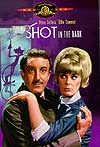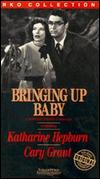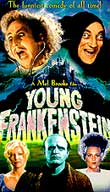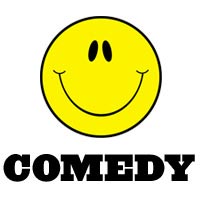 Comedy Films are "make 'em laugh"
films designed to elicit laughter from the audience. Comedies are light-hearted
dramas, crafted to amuse, entertain, and provoke enjoyment. The comedy genre
humorously exaggerates the situation, the language, action, and characters.
Comedies observe the deficiencies, foibles, and frustrations of life, providing
merriment and a momentary escape from day-to-day life. They usually have happy
endings, although the humor may have a serious or pessimistic side. Comedy Films are "make 'em laugh"
films designed to elicit laughter from the audience. Comedies are light-hearted
dramas, crafted to amuse, entertain, and provoke enjoyment. The comedy genre
humorously exaggerates the situation, the language, action, and characters.
Comedies observe the deficiencies, foibles, and frustrations of life, providing
merriment and a momentary escape from day-to-day life. They usually have happy
endings, although the humor may have a serious or pessimistic side.
See this site's Funniest
Film Moments and Scenes collection - illustrated.
In
mid-June 2000, the American Film Institute (AFI) selected America's 100
Funniest Movies. See
100
Funniest Films as presented by this site, as well as Premiere
Magazine's 50
Greatest Comedies of All Time. See also AFI's
10 Top 10 - The Top 10 Romantic Comedy Films and 101
Funniest Screenplays of All-Time.
Types of Comedies:
Comedies usually come in two general formats: comedian-led
(with well-timed gags, jokes, or sketches) and situation-comedies that are
told within a narrative. Both comedy elements may appear together and/or overlap.
Comedy hybrids commonly exist with other major genres, such as musical-comedy,
horror-comedy, and comedy-thriller. Comedies have also been classified in
various subgenres, such as romantic comedy,
crime/caper comedy, sports comedy, teen or coming-of-age comedy, social-class
comedy, military comedy, fish-out-of-water comedy, and gross-out comedy. There
are also many different kinds, types, or forms of comedy, including:
Slapstick was predominant in the earliest silent films, since they
didn't need sound to be effective, and they were popular with non-English
speaking audiences in metropolitan areas. The term slapstick was
taken from the wooden sticks that clowns slapped together to promote audience
applause.
This
is primitive and universal comedy with broad, aggressive, physical, and visual action, including harmless or painless cruelty and violence,
horseplay, and often vulgar sight gags (e.g., a custard pie in the face,
collapsing houses, a fall in the ocean, a loss of trousers or skirts, runaway
crashing cars, people chases, etc). Slapstick often required exquisite timing
and well-honed performance skills. It was typical
of the films of Laurel and Hardy, Abbott and Costello, W. C. Fields, The
Three Stooges, the stunts of Harold Lloyd in Safety
Last (1923), and Mack Sennett's silent era shorts (for example,
the Keystone Kops). Slapstick evolved and was reborn in the screwball comedies
of the 1930s and 1940s (see further below).
 More
recent feature film examples include the comedic mad chase for treasure
film by many top comedy stars in Stanley Kramer's It's a Mad, Mad, Mad,
Mad World (1963), and French actor/director Jacques Tati's mostly dialogue-free Mr. Hulot's Holiday (1953, Fr.), and Jim Carrey in Ace Ventura, Pet
Detective (1993) and The Mask (1994). More
recent feature film examples include the comedic mad chase for treasure
film by many top comedy stars in Stanley Kramer's It's a Mad, Mad, Mad,
Mad World (1963), and French actor/director Jacques Tati's mostly dialogue-free Mr. Hulot's Holiday (1953, Fr.), and Jim Carrey in Ace Ventura, Pet
Detective (1993) and The Mask (1994).
The Blake Edwards series of Pink
Panther films with Peter Sellers as bumbling Inspector Clouseau (especially
in the second film of the series, A Shot in the Dark (1964) with
Herbert Lom as Clouseau's slow-burning boss and Burt Kwouk as his valet
and martial arts judo-specialist) are also great examples. Cartoons are the quintessential
form of slapstick, i.e., the Roadrunner and Wile E. Coyote, and others.
This form of comedy was best exemplified by the expression-less face
of stoic comic hero Buster Keaton.
This was classically typified by the cruel verbal wit of W. C. Fields, the
sexual innuendo of Mae West, or the verbal absurdity of dialogues in the
Marx Brothers films, or later by the self-effacing, thoughtful humor of
Woody Allen's literate comedies.
Screwball comedies, a sub-genre of romantic comedy films, was predominant
from the mid-1930s to the mid-1940s. The word 'screwball' denotes lunacy,
craziness, eccentricity, ridiculousness, and erratic behavior.
 These
films combine farce, slapstick, and the witty dialogue of more sophisticated
films. In general, they are light-hearted, frothy, often sophisticated,
romantic stories, commonly focusing on a battle of the sexes in which both
co-protagonists try to outwit or outmaneuver each other. They usually include
visual gags (with some slapstick), wacky characters, identity reversals
(or cross-dressing), a fast-paced improbable plot, and rapid-fire, wise-cracking
dialogue and one-liners reflecting sexual tensions and conflicts in the
blossoming of a relationship (or the patching up of a marriage) for an attractive
couple with on-going, antagonistic differences (such as in The
Awful Truth (1937)). Some of the stars often present in screwball
comedies included Katharine Hepburn, Barbara Stanwyck, Claudette Colbert,
Jean Arthur, Irene Dunne, Myrna Loy, Ginger Rogers, Cary Grant, William
Powell, and Carole Lombard. These
films combine farce, slapstick, and the witty dialogue of more sophisticated
films. In general, they are light-hearted, frothy, often sophisticated,
romantic stories, commonly focusing on a battle of the sexes in which both
co-protagonists try to outwit or outmaneuver each other. They usually include
visual gags (with some slapstick), wacky characters, identity reversals
(or cross-dressing), a fast-paced improbable plot, and rapid-fire, wise-cracking
dialogue and one-liners reflecting sexual tensions and conflicts in the
blossoming of a relationship (or the patching up of a marriage) for an attractive
couple with on-going, antagonistic differences (such as in The
Awful Truth (1937)). Some of the stars often present in screwball
comedies included Katharine Hepburn, Barbara Stanwyck, Claudette Colbert,
Jean Arthur, Irene Dunne, Myrna Loy, Ginger Rogers, Cary Grant, William
Powell, and Carole Lombard.
The couple is often a fairly eccentric, but well-to-do female
interested in romance and a generally passive, emasculated, or weak male
who resists romance, such as in Bringing Up Baby (1938), or a sexually-frustrated,
humiliated male who is thwarted in romance, as in Howard Hawks' farce I
Was a Male War Bride (1949). The zany but glamorous characters often
have contradictory desires for individual identity and for union
in a romance under the most unorthodox, insane or implausible circumstances
(such as in Preston Sturges' classic screwball comedy and battle of the
sexes The Lady Eve (1941)). However, after a twisting
and turning plot, romantic love usually triumphs in the end. (See more discussion
later in this section.)
These
are dark, sarcastic, humorous, or sardonic stories that help us examine
otherwise ignored darker serious, pessimistic subjects such as war, death,
or illness. Two of the greatest black comedies ever made include the following:
Stanley Kubrick's Cold War classic satire from a script by co-writer Terry
Southern, Dr. Strangelove or: How I Learned to Stop Worrying and Love the Bomb
(1964) that spoofed the insanity of political and military institutions
with Peter Sellers in a triple role (as a Nazi scientist, a British major,
and the US President), and Robert Altman's M*A*S*H (1970), an irreverent,
anti-war black comedy set during the Korean War. Another more recent classic
black comedy was the Coen Brothers' violent and quirky story Fargo
(1996) about a pregnant Midwestern police chief (Oscar-winning Frances
McDormand) who solves a 'perfect crime' that went seriously wrong.
Hal Ashby's eccentric cult film Harold and Maude (1972) was an oddball love story and dark comedy about a suicidal 19 year-old (Bud
Cort) and a quirky, widowed octogenarian (Ruth Gordon), with a great soundtrack
score populated with songs by Cat Stevens. (See examples of other feature
films below for more.) John Huston's satirical black comedy Prizzi's
Honor (1985) starred Jack Nicholson as dimwitted Mafia hit man Charley
Partanna for the East Coast Prizzi family, who fell in love with West Coaster
Irene Walker (Kathleen Turner) - another mob's hitwoman. The film included
an Oscar-winning performance from Anjelica Huston as the vengeful granddaughter
of Nicholson's Don. Tim Burton's dark and imaginative haunted house comedy Beetlejuice (1988) featured Michael Keaton as the title character
in a dream house occupied by newlywed spirits Geena Davis and Alec Baldwin.
The shocking but watchable first film of Peter Berg, Very Bad Things
(1998) told the dark and humorous story of a 'bachelor' weekend in Las
Vegas gone bad for five guys when their hired stripper/prostitute was accidentally
killed.
- Parody or Spoof - also Satire, Lampoon and Farce
These specific types of comedy (also called put-ons, send-ups, charades,
lampoons, take-offs, jests, mockumentaries, etc.) are usually a humorous
or anarchic take-off that ridicules, impersonates, punctures, scoffs at,
and/or imitates (mimics) the style, conventions, formulas, characters (by
caricature), or motifs of a serious work, film, performer, or genre, including:
 the
Marx Brothers' satiric anti-war masterpiece Duck Soup (1933) with anarchic humor the
Marx Brothers' satiric anti-war masterpiece Duck Soup (1933) with anarchic humor- the western spoof Cat Ballou (1965)
- Woody Allen's Japanese monster film parody What's
Up, Tiger Lily? (1966)
- the 'genre' films of Mel Brooks (the quasi-western Blazing
Saddles (1974), the quasi-horror parody-spoof film Young
Frankenstein (1974), the inventive Hitchcock spoof/rip-off High
Anxiety (1977), the Star Wars
(1977) spoof Spaceballs (1987), and his swashbuckler
send-up Robin
Hood: Men in Tights (1993))
- Herbert Ross' Play It Again,
Sam (1972) poked fun at Woody Allen as an insecure nebbish-hero
who worshipped an imaginary, trench-coated, archetypal tough-guy detective
(a la Humphrey Bogart)
- Silver Streak (1976) - a
comic thriller parody of Alfred Hitchcock's 'train' pictures, with Gene
Wilder and Richard Pryor (their best film together) onboard the Silver
Streak from LA to Chicago
- Neil Simon's scripts for The Cheap Detective (1978) and Murder By Death (1978) spoofed Agatha Christie detective films
- Jim Abrahams' and the Zuckers' revolutionary comedy Airplane!
(1980) - a sophomoric parody of the earlier disaster
series of Airport
(1970) films and the original Zero Hour! (1957); their The
Naked Gun (1988) series parodied TV cop shows, and Top
Secret! (1984) ridiculed Cold War agents and espionage spy
films (and Elvis Presley films); Abrahams' military comedy Hot
Shots! (1991) was
a genre parody/spoof of Top Gun (1986), while Hot Shots!
Part Deux (1993) parodied Rambo: First Blood Part II (1985)
- in The Freshman (1990), Marlon Brando (as Carmine
Sabatini) poked fun - with brilliant parody - at his own characterization
of Don Corleone in The Godfather (1972)
- Carl Reiner's Fatal Instinct (1993) spoofed suspense
thrillers and murder mysteries such as Basic Instinct
(1992)
- Gene Quintano's Loaded Weapon I (1993) made fun
of Lethal Weapon (1987) as well as The Silence
of the Lambs (1991), Basic Instinct (1992),
and Wayne's World (1992)
- the Austin Powers films (1997, 1999, 2002) - parodies of the James Bond 007 films
- the Scream films (1996, 1997, 2000) - spoofs
of slasher horror films
- Barry Sonnenfeld's Men in Black (1997) - a sci-fi
comedy farce based on a comic book series that poked fun at alien invasion
films, with Tommy Lee Jones and Will Smith as government agents (with
camaraderie similar to Mel Gibson and Danny Glover in the Lethal Weapon series) battling about 1500 Earth-dwelling, other-worldly extra-terrestrials
in the New York area; a sequel appeared in 2002
- Galaxy Quest (1999), about the cast (including
Tim Allen, Alan Rickman, and Sigourney Weaver) of a 70s sci-fi TV series
in reruns, this was a parody of sci-fi TV, Star Trek itself, and
cultish "Trekkie" activities
- director Nora Ephron's romantic comedy You've Got
Mail (1998) updated and paid homage to Ernst Lubitsch's classic The
Shop Around the Corner (1940), with leads Tom Hanks and Meg Ryan in
their third teaming (after their previous hit with Ephron - Sleepless
in Seattle (1993)), replacing James Stewart and Margaret Sullavan
as feuding-by-email Manhattan bookstore owners
- Last Action Hero (1993) - a spoof of action films
This category may also include these widely diverse forms
of satire - usually displayed as political or social commentary,
for example:
- Billy Wilder's sex farce The Seven
Year Itch (1955) - a parody of a conventional Hollywood romance
- Terry Gilliam's tasteless but hilarious Monty Python's
The Meaning of Life (1983) and The Life of Brian (1979) - an
irreverent parody of religious films
- the witty Monty Pythonesque A Fish Called Wanda (1988),
co-scripted by veteran John Cleese (with the character name of Archie
Leach - named after Cary Grant's real name) and directed by veteran Charles
Crichton (whose film career was responsible for such classics as The
Lavender Hill Mob (1951)); it was both an acclaimed black comedy and
caper farce about a search for a stolen cache of diamonds; the title referred
to both a fish and the name of Jamie Lee Curtis' character
- writer/director Albert Brooks' satirical Real Life
(1979) - a pseudo-documentary on 'real' small-town suburban family
life
- Woody Allen's pseudo-documentary Zelig (1983) with its use of vintage historical clips to portray a human cipher or
chameleon in various time periods
- Rob Reiner's largely-improvised show-biz mockumentary This is Spinal Tap (1984) about a non-existent British heavy metal
rock band on tour of third-rate venues
- the serious-comedic political satire of Tim Robbins'
pseudo-documentary (or fictional mockumentary) Bob Roberts (1992) about running for Senatorial office; Tanner '88 (1988) was a similar
made-for-TV mini-series about a fictional Presidential candidate (Michael
Murphy)
- Steven Soderbergh's Schizopolis (1996) - an irreverent,
bizarre, and absurdist media satire
- Christopher Guest's Waiting for Guffman (1996) - an intelligent satirical parody (and mockumentary) about small-town
'drama queen' hopefuls
In many comedies, there is much overlap with the category of 'farce', since the term has now been broadened and extended (from the early part of the 20th century) beyond its origins and roots in silent film (and early talkies) comedy (W.C. Fields, Charlie Chaplin, The Marx Brothers, and Buster Keaton to name a few), and the works of The Three Stooges. Now, farces - and farcical elements in films, may include fairly outrageous plots, unlikely and absurd circumstances, frantic-paced action,
mistaken identities, a major transgression or hidden secret (i.e., often an extra-marital infidelity) sometimes based upon a misunderstanding, and lots of verbal humor, absurdities and physical slapstick, often with a concluding chase scene of some kind. Recently, farces have widened their scope by deliberately and satirically mocking established genres and standard filmic conventions themselves:
- Classic screwball comedies and other classic comedies: such as Trouble in Paradise (1932), Twentieth Century (1934), My Man Godfrey (1936), His Girl Friday (1940), To
Be or Not to Be (1942), The More the Merrier (1943), Arsenic and Old Lace (1944), Born Yesterday (1950), The Seven Year Itch (1955), Some Like It Hot (1959), etc.
- UK comedies: the British Ealing Studios comedies (The Lavender Hill Mob (1951)), the grotesque commentaries found in the Monty Python films, Tom Jones (1963)
- Kubrick's classic, black comedy: Dr. Strangelove: Or... (1964)
- Other comedies in series: the Hope/Crosby 'Road' movies, the Peter Sellers/Inspector Clouseau Pink Panther films, the Mel Brooks comedies (beginning with The Producers (1968) and including such films as Spaceballs (1987), Robin
Hood: Men in Tights (1993), and Dracula: Dead and Loving It (1995)), the Abrahams/Zucker/Zucker films such as Airplane! (1980) and Hot Shots! (1991), some Woody Allen films (i.e., Love and Death (1975)), Carl Reiner/Steve Martin films: (i.e., The Jerk (1979), The Man with Two Brains (1983), and All of Me (1984)), the Mr. Bean movies (i.e., Bean (1997))
- Other recent examples: What's New, Pussycat (1965), A Funny Thing Happened on the Way to the Forum (1966), Murder by Death (1976), Tootsie
(1982), Planes, Trains and Automobiles (1987), Peter Bogdanovich's Noises Off... (1992), There's Something About Mary (1998), Waking Ned (1998), South Park: Bigger Longer & Uncut (1999), Anchorman: The Legend of Ron Burgundy (2004), The 40 Year Old Virgin (2005), The Simpsons Movie (2007), etc.
|
